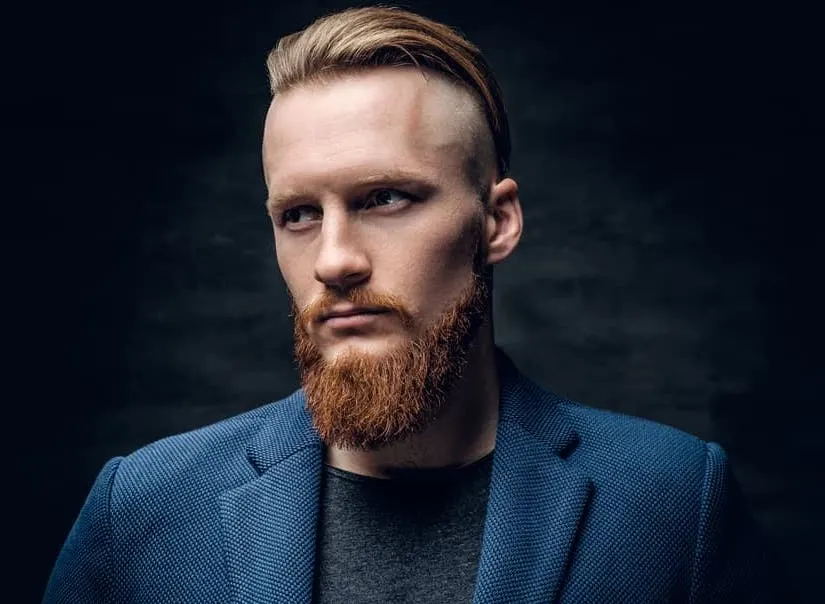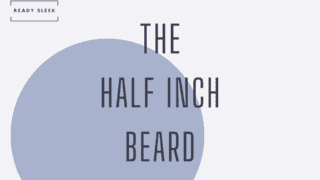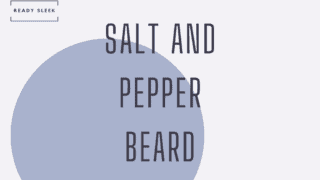Both beard brushing and beard combing have become pillars of the modern man’s grooming regimen. But there are aspects of both that leave bearded men scratching their glorious chins in confusion.
A poorly understood area of the beard is under the chin. Specifically, how are you supposed to brush and comb the area under the chin?
Due to the unpredictable nature of hair growth in this area, it can be difficult to tame. The hairs of a “neckbeard” often grow in various directions, and believe me, no neckbeard is the same as another. For this reason, no single answer would be enough as an explanation. Some men should brush forward, some straight down, and some backward.
This article will help you determine what direction you should go for with your specific beard.
Plus, if you’re interested in finding out my most recommended beard trimming and grooming products of the year, click here.
First, it’s important to gain a basic understanding of what a beard consists of. In other words, let’s break down the anatomy.

Basic Beard Anatomy
There are three core components of a beard that you absolutely need to know about. The cheek beard, the fore beard, and the neckbeard. The neckbeard is the hair under the chin and is the area we’ll be focusing on in this article.
The cheek beard is, as you’ve probably already guessed, the hair over the cheeks.
The fore beard is the hair over the chin, which usually forms the lowest point of the beard. It can get long depending on what style you’ve gone for.
The neckbeard is the hair beneath your jawline, under your chin, and over your neck. If left untrimmed, it can become unsightly and crawl toward your chest hair.
Trimming and defining the neckline is crucial in maintaining a well-groomed beard. It forms the border between your neckbeard and neck skin and is the key to ensuring a tamed neckbeard.
But another key to taming the neckbeard is brushing, and at times also combing it. Let’s talk about how you would do it.
How To Brush Your Beard Under The Chin
As I mentioned above, you have three main options:
- Brushing it forward and upward toward your chin
- Brushing it straight down
- Brushing it backward and downward
Although beard brushing direction is otherwise a pretty straightforward, universally agreed-upon concept, this area is different.
The method you choose will depend on multiple factors, including the direction of hair growth, the ratio of neckbeard to fore beard, and your face shape.
This will become clearer as I discuss each of the options in more detail.
1. Forward and upward toward your chin
From the anatomy diagram above, you may have noticed that the hair under the chin (the neckbeard) lies directly behind the fore beard. This is a pretty powerful realization and can be used to your advantage.
The reason a lot of men brush their neckbeards forward and upward toward their chin is that it gives the fore beard a lot of support.
It can add volume, length, and bulk to the fore beard. For men with a weak chin, this can be a game-changer.
Taking into account the ratio between your neckbeard and your fore beard is also important. In some men, the growth rate of the neckbeard can be much quicker than that of the fore beard.
This can lead to the face looking wider, which for square and round-faced men would not be an option. Brushing the neckbeard upward will make it look shorter while adding prominence to the fore beard.
A disadvantage of brushing upward is that, in general, it is against the grain (against the direction of hair growth). This may not be the case, because as I said, neckbeard hairs can grow in all sorts of directions.
But in general, this principle holds true. Brushing against the grain can look untidy, and also lead to a patchy appearance.
Try it out, because this may be perfect for you.
2. Straight down
This one is pretty simple. It’s often the easiest path to follow. Brushing the neckbeard straight down (toward the chest) isn’t for everyone, however.
It often suits men with short, well-maintained beards, and well-defined necklines. Brushing straight down can look neat, sharp, and slick.
If you’re not particularly bothered about adding support to the fore beard, this is great. Short-bearded men usually aren’t as particular about this anyway.
But for medium or long-bearded men, this may not be the case. The reason for this is that it can add length to the neckbeard, something you may want to avoid.
Increasing the length of the neckbeard relative to the fore beard can make the fore beard seem weak.
It also reduces support for the fore beard, making it look less full and bulky.
With longer beards, brushing straight down at the level of the chin can also cause a very visible “dip” to form at the jawline. This can look strange and can be difficult to correct without changing the direction in which you brush.
So to summarize, if you’re a short-bearded man, brushing straight down is something worth trying. If you are long-bearded, or perhaps even just medium-bearded, this is probably not for you.
3. Backward and downward along the neck
Run your fingers across your neck hair. You can determine the direction of hair growth in different parts.
You’ll probably notice that as you run them from your Adam’s apple downward and backward, it feels pretty smooth. You may not, but you probably will.
This is because you’re running your fingers with the grain (in the direction of hair growth). So, brushing in this direction will mean you’re actually brushing with the grain more often than not.
Brushing downward and backward, for that reason, often leads to quite a tidy result.
It also adds a lot of support to the fore beard from the left and right. This can give your lower face more width – something you may love if you have a pointy chin you’re looking to mask.
Plus, giving the fore beard more support from the sides can overall make the beard look bulkier and more prominent.
Much like brushing the hair under the chin forward and upward (option 1), brushing backward and downward can reduce neckbeard length.
Again, this is great for reducing the prominence of a neckbeard that just grows faster than the fore beard. Keeping it “hidden” by tucking it back like this is a good option.
However, bear in mind that brushing it like this can lead to a “flared out” appearance at the sides. It can cause a point to form under the ears which may just be out of keeping with the style you’re going for.
Summary
In reality, you may find yourself choosing a mixture of all of the above. Every man’s “beard anatomy” is different.
For example, you may find that your fore beard is shorter and weaker on the right side. Because of this, you may choose to brush your neckbeard backward and downward on the right to give it support, while brushing the left side straight down to help balance things out.
As you can see, it’s the principles that you need to remember, as there’s really no way of learning “a method” that will work for every single bearded individual.
How To Comb Your Beard Under The Chin
This section will be short and sweet. The same principles and directions apply to combing under your chin. There’s no difference concerning the direction you choose.
It’s more important to discuss whether you would comb under your chin as opposed to brushing and whether you should do both.
Combing a beard has its benefits. But its main advantages over brushing are its styling and detangling capabilities. Because of this, combing is particularly beneficial when your beard becomes longer.
As a beard becomes longer, it becomes harder for the bristles of a boar bristle beard brush to reach the deeper hairs. These hairs are therefore more likely to tangle, and the longer teeth of a beard comb are often the only remedy.
So, as your neckbeard becomes longer, whether you choose to do it forward, straight down, or backward, a comb may be necessary to detangle those deeper tangles.
It can also be great for accentuating a style you’re trying to pull off with the hair under your chin. For example, that “flared out” appearance at the sides may be what you’re going for.

How can I prevent the “neckbeard” look?
So, “neckbeard” is also a derogatory term used to describe the unsightly layer of hair that crawls over the neck from the chin to the chest.
This isn’t what I’m helping you to groom. All beards should have a well-defined neckline, below which there should be minimal amounts of hair. It’s a quick fix for men looking to make their beard look less accidental.
The only hair on your neck should be above your neckline. This is the hair you should be looking to brush or comb. Below your neckline, there shouldn’t be anything left to brush or comb.
If the fore beard is long, the neck hair is less visible, so this isn’t as much of an issue.
But the neckline should still be trimmed for the sake of proper beard grooming.
The easiest way to prevent a neckbeard is to trim a decent neckline at the right level – not too high, not too low.
Conclusion
The under-chin area has plagued many a beardsman for eons. As with most beard grooming habits, there really is no “right way” to do it.
Every beard is different. Over time, as you become more and more aware of the nuances of your specific beard, it will become easier.
As you’ve come to realize, this article wasn’t a step-by-step routine. It was more of a collection of core principles that you can apply to the under-chin area as you do your own testing.
Although there are specific techniques and there is specific guidance you should follow, brushing and combing should always be considered an art.
Have fun with it.
Ready Sleek founder. Obsessed with casual style and the minimalist approach to building a highly functional wardrobe. Also a fan of classic, vintage hairstyles.







